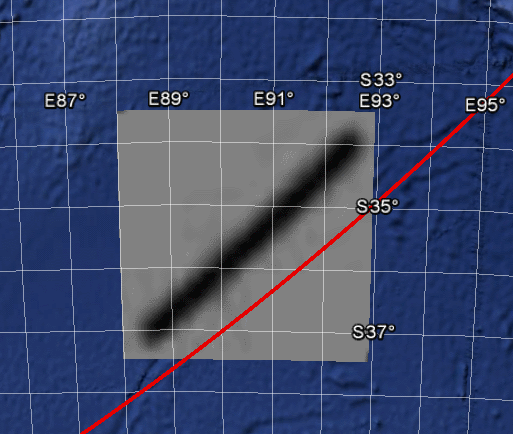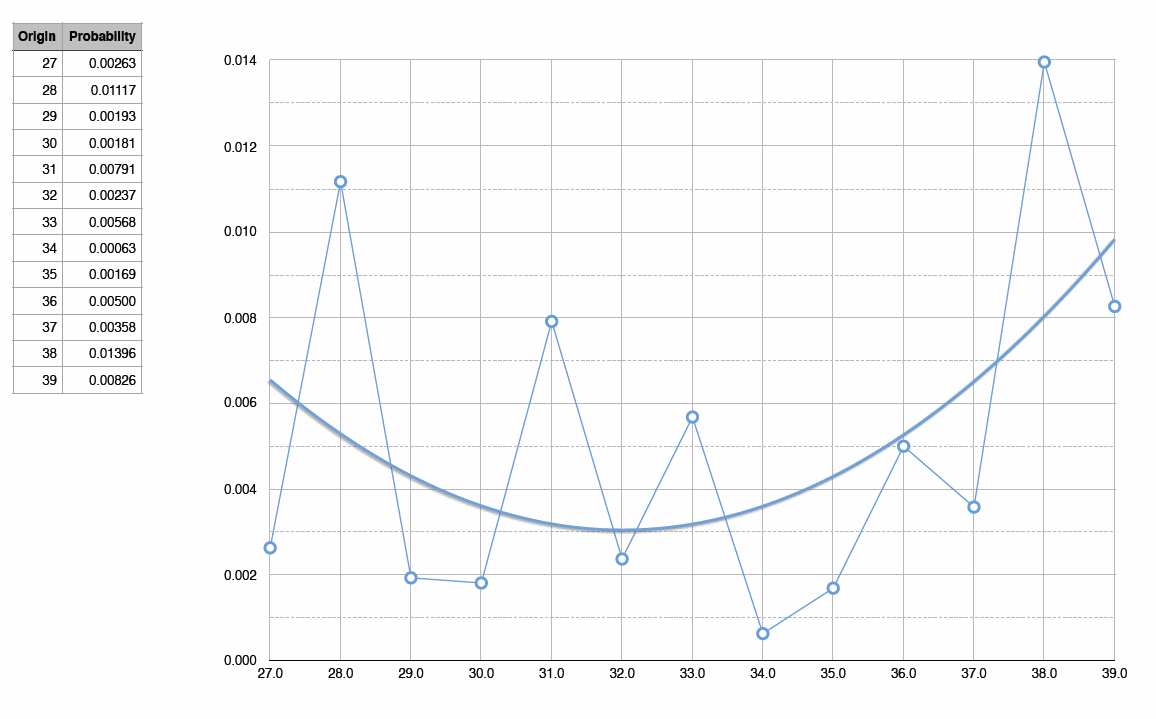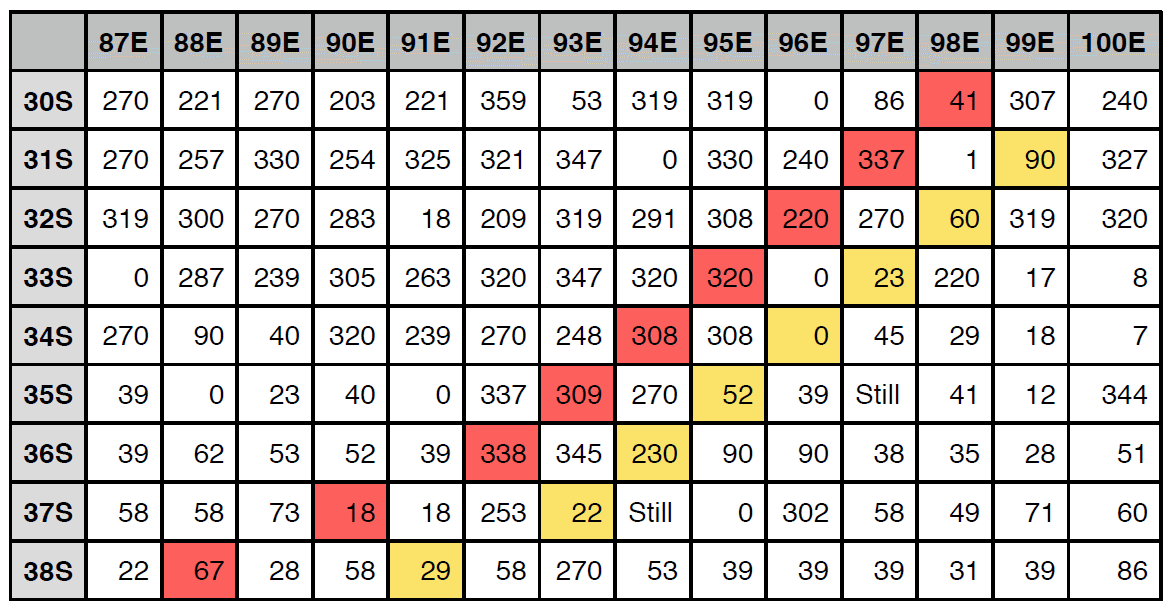Implications of the Absence of MH370 Debris on the Coast of Western Australia
Richard Godfrey and Duncan Steel
2016 May 11
Updated May 12
Introduction
Several different people/groups have published reports on the drift modelling of floating debris from MH370. Brock McEwen’s Comparative Analysis of drift studies (2015 December 07) is available here. Most recently (2016 April 25) he has published MH370: Probabilistic Analysis of Shoreline Debris, which is available here.
There is an important conclusion in McEwen’s report, which prompts the present post here. He finds that, based on modelling carried out by researchers at the International Pacific Research Center (IPRC) at the University of Hawaii, if the crash occurred in the priority search area then there should have been dozens of items of MH370 debris found on the coast of Western Australia by now, and yet there have been no such confirmed identifications. As McEwen states in an email message, “The bottom line seems inescapable: either IPRC’s probabilities are wrong, my model is wrong, or the current search area (36-40 degrees south latitude) is wrong.”
(Note that, as described below, the IPRC extended start line for their drift modelling stretches from 34S to 37S; however, it is non-coincident with the 7th arc, as McEwen pointed out, but rather lies some distance to the northwest of that arc, as is confirmed below.)
The core question that is addressed in this post is as follows:
Can we reconcile the discovery of debris in the western Indian Ocean along with the non-discovery of debris on the coast of Western Australia with a crash location on or near the 7th arc, and if so what does this tell us about where the crash occurred, in terms of the latitude (near the arc)?
An Omission from the First Version of this Post (May 11)
It is noted that an analysis by Henrik Rydberg published in early-August 2015, soon after the flaperon was discovered in La Réunion, addresses all the essential points covered in the present post, and more; we apologise to Rydberg for having omitted to mention his analysis in the May 11 version of this post. Further discussion of Rydberg’s conclusions are included at the end of this post.
A few background comments
Working out likely end-points for floating MH370 debris from any putative crash location on or near the 7th arc between 29S and 40S can be very confusing.
Whilst the West Australian Current (WAC) would be expected to pick up such debris and carry it initially north-east, this does not imply that any must end up on the coast of Western Australia (WA). (Note that the “coast of WA” in question here is limited to that facing west onto the Indian Ocean, and not the coast from Albany eastwards, nor that eastward of, say, Port Hedland or Broome.) The WAC trends anti-clockwise and feeds into the westward-flowing South Equatorial Current (SEC) which would then be able to take floating items to locations where MH370 debris has been found in the western Indian Ocean (Réunion, Rodrigues) and on the African coast (Mozambique, South Africa), with some passing to the north of Madagascar and some to the south. Some items will turn southwards out of the SEC before reaching the longitude of Madagascar, and some others will make that turn (continuing anti-clockwise) in the Agulhas Current off the southern coast of South Africa, and then return in another year or so from now to the approximate region where they started (i.e. the MH370 crash site).
Returning to the WAC and the floating debris carried in it, the flow is broadly parallel to the WA coast, and northwards. Between the WAC and that coast, however, is the Leeuwin Current (LC), which flows southwards, largely over the continental shelf (which extends a long way westwards from the coast, especially at latitudes north of Geraldton). As the Wikipedia page for the LC says, “The West Australian Current … produced by the West Wind Drift in the southern Indian Ocean … flow[s] in the opposite direction, producing one of the most interesting oceanic current systems in the world.”
What this would appear to mean is that for debris from MH370 to reach the coast of WA (so as to be found there on the beaches or rocks) it must drift slightly eastwards out of the general WAC and then be picked up by the counter-flowing LC, and make land from there. A partial barrier to this is posed by upwelling at the edge of the continental shelf; such upwelling also occurs at Broken Ridge.
An immediate response to the above overall picture (if it is correct) is that the places one would look for MH370-derived items might be the islands of Shark Bay, and the reefs of the Houtman Abrolhos further south, off Geraldton. However, there will be others with far better knowledge of where jetsam and flotsam tends to wash up, and its origins.
The IPRC start locations are not on the 7th arc
The IPRC researchers state that their assumed source (i.e. range of start positions in their drift study) is “equi-distributed between 37S and 34S along the 7th arc” (e.g. the caption to their Figure 2 on this webpage). However, this appears not to be the case, as was indicated by McEwen (see Figure 19 in his Comparative Analysis). As he noted, the extended source used in the IPRC study seems to be a line that is curved, and is inside the 7th arc but is not parallel to it; the line does run from 37S to 34S though.
To confirm the location of the IPRC-assumed source (set of starting points) their Figure 3 (which plots their source line with a white background) was georeferenced, converted into KMZ format, and brought into Google Earth. The resultant screen grab is shown below, with the 7th arc at 35,000 feet plotted in red for reference.
(For anyone who wants it, the KMZ file for that IPRC line is available here; and the 7th arc KMZ file is here.)

Figure 1: The red line indicates the 7th arc for an assumed altitude of 35,000 feet, and the broad black line shows the IPRC-assumed source for drift modelling, which lies about one degree to the northwest of that arc.
The reason for this discrepancy is not known at this stage. Obviously such a simple error leads one to question the veracity of the overall results obtained, but for present purposes it will be assumed that the IPRC drift modelling outcomes do indeed represent what might be anticipated to occur given the extended source location shown above.
It might be noted that, naïvely, one might suppose that floating items modelled as starting from the IPRC source would seem less likely to reach the coast of WA than items actually starting their drift further east, on the 7th arc.
In passing it is noted that it is unfortunate that the IPRC drift modelling results as publicly available are aggregated for all points along their line between 34S and 37S; it would have been useful to be able to compare results for, say, start points at 34S, 35S, 36S and 37S, as will become clear from the discussion below.
Drift Modelling Analysis
The drift modelling described here makes use of the Adrift website. The coast of WA was defined for locations between 22S 113E south to 34S 114E as shown in the far left column in the table below.

Table 1: Drift probabilities and earliest arrival times on the WA coast for different assumed start locations near the 7th arc.
For each assumed point of origin of debris between 27S and 39S near the 7th Arc (longitudes rounded to the nearest degree so as to fit against the required inputs for the Adrift model), the earliest time when the coast was reached was determined. These times (the model uses two-month jumps) are shown in the table above, along with the associated probabilities of reaches those points on the coast from the stipulated starting positions.
It is emphasized that the results appear ‘noisy’, with apparent jumps in probability that seem unphysical, some coastal locations being indicated to have zero probability of receiving debris whilst adjacent locations have substantial values. The results can therefore be regarded only as giving some general indications of what may have occurred.
This noisiness can be easily seen in the chart below, wherein the total probabilities of reaching the shore of WA for each origination point are plotted against the latitude of those start points. A tentative deduction from the best-fit curve shown is that there is a lower likelihood of reaching the WA coast if the crash location were not near the extreme latitudes shown, with the minimum in the curve occurring for latitude 32S, and the minimum in the output data at 34S.

Figure 2: Summed drift probabilities to the WA coast for different assumed start locations/latitudes near the 7th arc.
A fundamental observation we are trying to explain here is the fact that MH370-derived debris has been found in the western Indian Ocean, but not on the coast of WA. We should be comparing derived probabilities, therefore.
For an origin (i.e. putative crash location) at 34S, 94E the summed probability for the WA coast in the table above is just 0.00063. From other locations on/near the 7th arc the values are around 0.002 or higher (i.e. summed WA coast probabilities). By comparison, for the ‘No Step’ item found in Mozambique the maximum probability calculated was 0.00202, starting from 30S. For the flaperon found in Réunion, the maximum possibility derived was 0.00134, also for a start at 30S.
On this basis it might be concluded that for the least amount of debris to land on the West Coast of Australia, the most likely MH370 crash location is around 34S 94E on the 7th arc. Further, the low probabilities of debris starting there and arriving there on the WA coast are not inconsistent with the discovery of debris across the Indian Ocean to the west.
Further Discussion
Obviously we would like to understand the above results in terms of how they come about, in case insights might arise that assist the search for the MH370 crash location.
What may be significant is that the 7th arc is close to the east-west divide in ocean currents, for the two months after March 2014. Consider the location identified above (i.e. 34S 94E) as being the least-likely to result in debris reaching the WA coast. The drift path from that point indicates a most-likely heading that is north-westerly (azimuth around 308°).
That value is shown in the table below. In this table are mapped the highest-probability drift directions derived from the Adrift model for the two months commencing March 2014 as a function of initial latitude and longitude. The boxes coloured red indicate the approximate 7th arc (rounding to the nearest degree being necessary). The yellow boxes indicate locations that might have been reached should MH370 have been glided on a continuation of its flight path after fuel exhaustion at the 7th arc.

Table 2: Drift directions for different start locations across the two months starting with March 2014.
Whilst the directions tabulated might be regarded as being somewhat scattered, reflecting the vagaries of current flows and eddies (and note that in some locations the most-likely behaviour is that floating debris would go nowhere during those two months; i.e. it remains ‘Still’), in broad scope the values in the upper left parts of the table indicate current flows that are generally northwest, whereas those in the lower rights parts of the table indicate current flows more towards the northeast. This is not unexpected, being reflected in the anti-clockwise flow of the WAC.
For example, a crash point at 35S 95E (about 78 NM outside the 7th arc) would normally correspond to the equivalent controlled ditch end point (if fuel exhaustion occurred at 34S 94E). However, 35S 95E is on the other side of the east-west divide in ocean currents and therefore debris will not drift back toward 34S 94E, but rather head off in a north-easterly direction around 052°. The general pattern being an anti-clockwise path, most of the debris that starts off heading north-east will eventually circle round to a northerly, then westerly path.
For those points between 32S and 36S on and just inside the 7th arc the highest probability drift direction for the two months from March 2014 is westward; outside the 7th arc, though, the drift pattern changes to an easterly or north-easterly direction. An initial north-easterly path will still reach the locations of the various finds made to date, it will just take longer to get there than an initial north-westerly path.
Concluding Remarks
Obviously the situation is complicated, and deserves/requires further study. The general picture arrived at, however, is that if the crash of MH370 occurred on or inside the 7th arc between latitudes of 31S-36S then the resultant floating debris may be anticipated to have drifted initially towards the northwest and then been transported across the Indian Ocean by the SEC; under this circumstance it seems that debris arriving on the coast of WA is unlikely, possibly explaining its non-detection.
On the other hand, if MH370 crashed outside of the 7th arc between 31S-36S, or on the arc but further south, then floating fragments are more likely to have drifted to the coast of WA. The non-discovery of debris there argues against such crash locations, therefore.
In 2015 August, on the basis of the flaperon found on La Réunion, Van Gurley (Metron, Inc., Reston, Virginia) suggested that the underwater search should be shifted about two degrees northwards from the ATSB priority search area. That is, the identification of debris from MH370 in the western Indian Ocean may be interpreted as being indicative of a crash location not so far south as 36-40S, but a few degrees further north, a suggestion that we confirm here. Further, we find here that the non- identification of debris on the coast of Western Australia may be interpreted as indicating a crash location that is on or inside the 7th arc, which may be regarded as being additional evidence against any scenario in which MH370 is thought to have continued for some distance beyond the 7th arc.
All readers are urged to refer to Rydberg’s analysis from early-August 2015. He identified 34S 94E as being the most likely start point for the flaperon, and made various predictions about where and when debris would arrive onshore elsewhere. Rydberg indicated that a crash location as far south as the ATSB priority search zone was unlikely to have resulted in the flaperon reaching La Réunion; that much more debris would be expected to arrive on shorelines in the western Indian Ocean (and, indeed, another four fragments of MH370 have so far been found); and that comparatively small numbers of debris items should be expected to reach the WA coast, the likelihoods of washing up across the other side of the Indian Ocean being far higher.
The discovery of (so far) a number of MH370-derived debris items on coastlines in the western Indian Ocean but none at all on the shores of Australia therefore present a situation that is consistent with the crash location of MH370 having been further north than the area where the underwater search has been focussed, with 34S 94E being the ‘best bet’ based on analyses using the Adrift model.